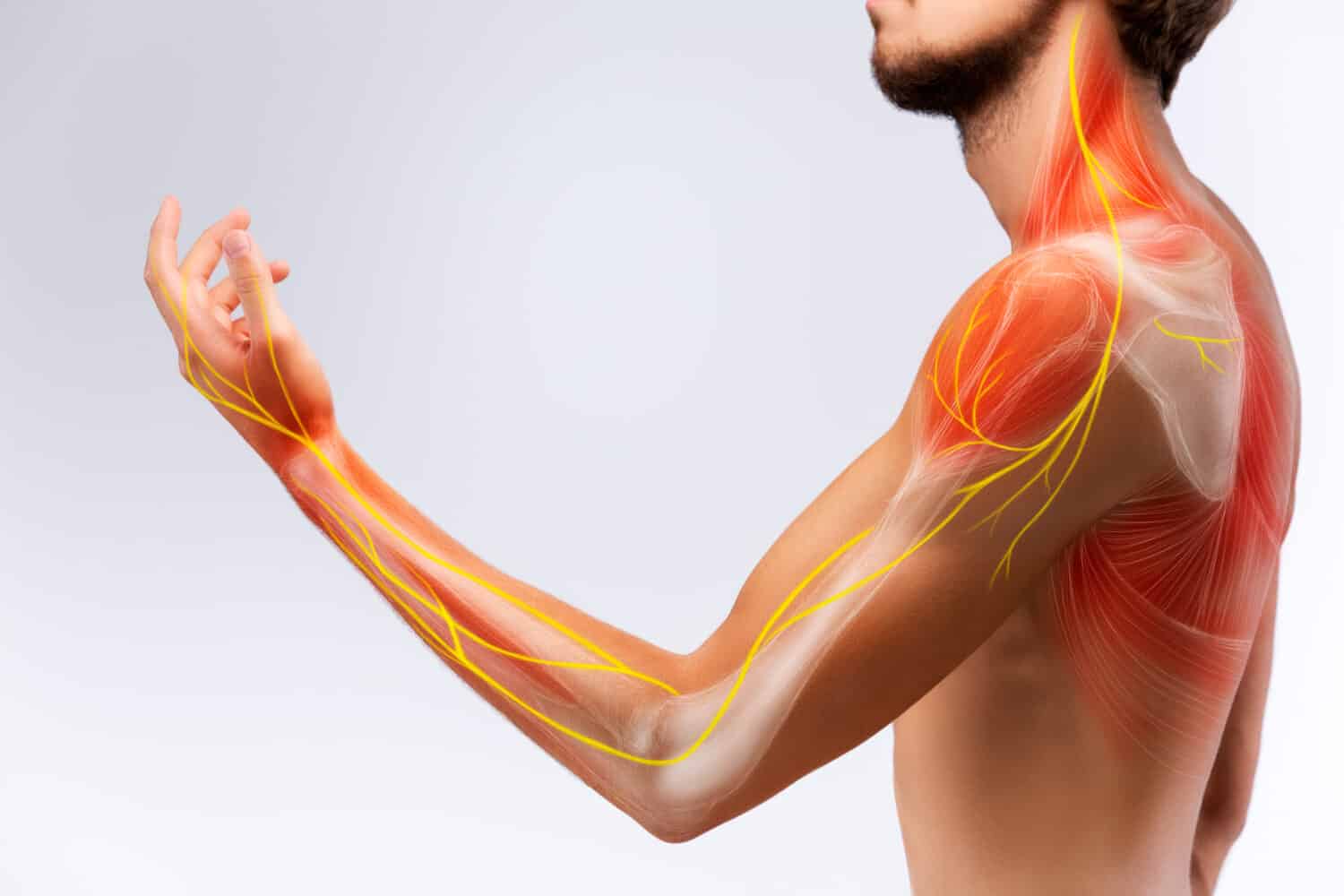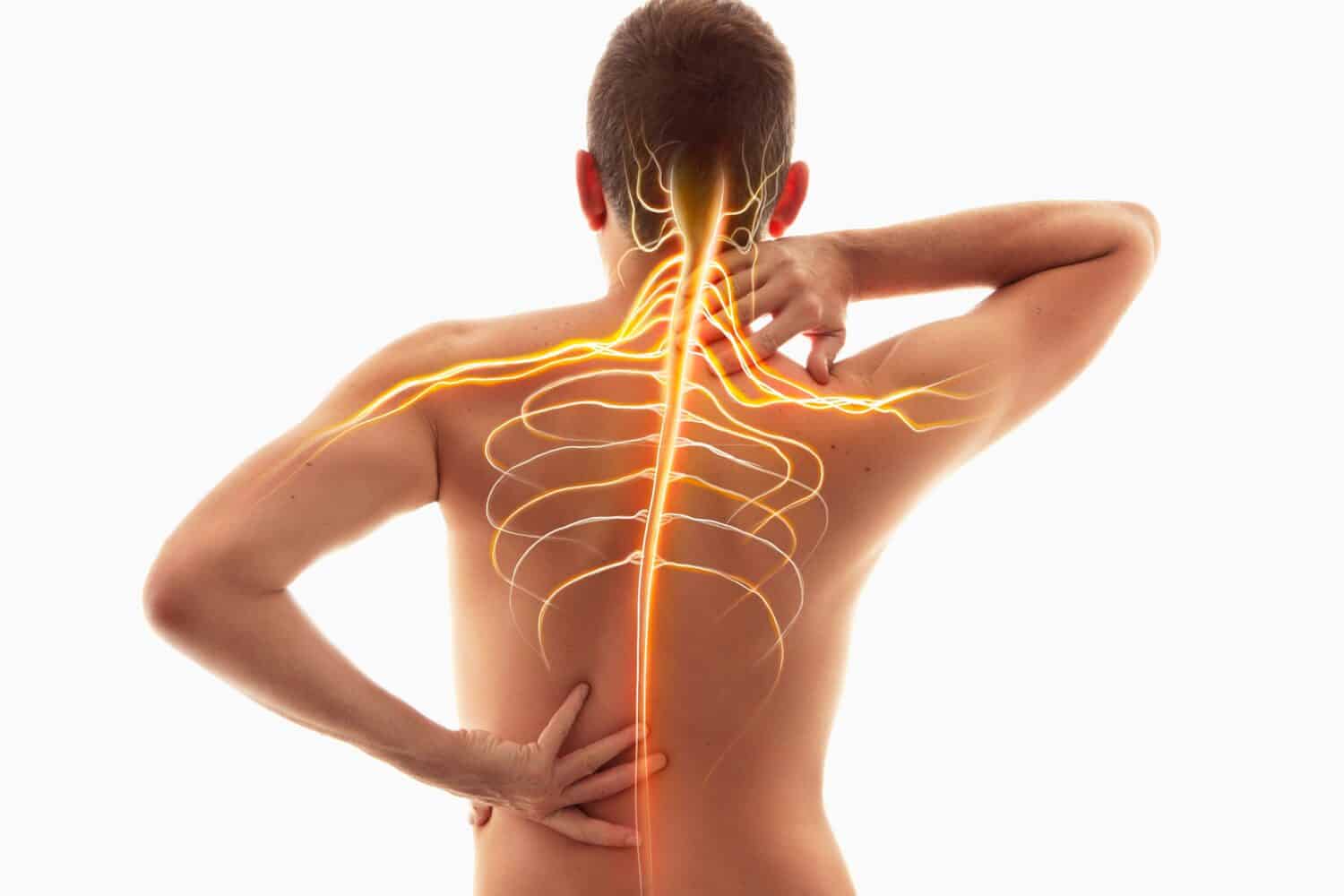The nervous system is a communication channel network between the brain and the body via the spinal cord. Our nervous system has two main neurons that help in sensing and reaction: sensory and motor neurons, known as afferent and efferent nerves. They are located in the peripheral nervous system outside the central nervous system.

Afferent and efferent nerves are the sensory and motor divisions of the peripheral nervous systems.
©BigBlueStudio/Shutterstock.com
The nervous system enables our bodies to move, detect danger, and perform other functions. The brain receives impulses from the nerves and sends motor signals through the same channel of nerves. Received signals are interpreted, and a relevant output to counter the stimuli is sent to the concerned organ or body part.
Here is a brief introduction of the nervous system and its various components:
Structure of the Nervous System
A vertebrate’s nervous system has two main parts: the Central Nervous System or CNS (composed of the brain and spinal cord) and the Peripheral Nervous System or PNS. PNS is a neuron grid that connects the whole body to the CNS. The two primary roles of the PNS are:
- Transmit output information from the brain to the rest parts of the body.
- Bring input information from other body parts to the brain and spinal cord for processing.
Accordingly, the communication between CNS and the whole body requires channel/vessel/messenger neurons. Thus, afferent and efferent nerves are the two sets of channels or messengers that enable communication between the CNS and the rest of the body.
We will discuss the definition, concept, differences, roles, and disorders relating to the afferent and efferent nerves in the nervous system.
Definitions and Concepts of Afferent and Efferent Nerves
Afferent and efferent nerves are the sensory and motor divisions of the PNS, respectively. The nervous system is made of electrically excitable neuron cells. A typical neuron has the following:
- Somas are the cell body containing cytoplasm, nucleus, mitochondria, and other organelles. The nucleus controls all cell activities, which also bears the genetic coding.
- Dendrites are extensions from the cell body reaching out to other neuron cells. Dendrites carry the receptors for receiving incoming signals from other cells.
- Axon is the narrow extension from the opposite side of the neuron cell body containing smaller branches for sending signals to other cells. Axons are commonly enclosed in a myelin sheath to enable speed in transmission.
Multiple neurons work together to enable the transmission of signals in and out of the central nervous system. A nerve comprises axons transmitting signals in a parallel from the same point.
Afferent Nerves
Afferent nerves collect and deliver messages to the CNS. These nerves make you sense temperature variation or an insect crawling on your skin. The nerves play a crucial role in all the primary senses.
The afferent nerves are also called sensory neurons. Their main work is to carry signals from sensory receptors found in other organs in the body to the CNS.
Efferent Nerves
Efferent nerves, on the other hand, deliver instructions from the CNS to other parts of the body. These instructions ignite a reaction based on the received message from afferent nerves. An example is a reaction to withdraw your hand when you touch a hot surface.
However, the nerves are not limited in control of reflex reactions. They are forever working to control the body. The efferent nerves are also called the motor neurons. Their primary role is conveying motor signals from the CNS in the brain and spinal cord to body glands and muscles.
Both afferent and efferent nerves work together, enabling vertebrates to sense and respond to different stimuli, but the two are not connected directly. Instead, a third type of nerve called the association neuron or interneuron bridges the two to enable communication.
Differences Between Afferent and Efferent Nerves in the Nervous System
The nervous system comprises the sensory receptors, association neurons, and motor neurons. Although afferent and efferent nerves are different, they share some similarities as follows:
- Both afferent and efferent nerves are essential parts of the peripheral nervous system.
- Both are connected to the central nervous system.
- Both nerves transmit nerve signals to and from other body organs and muscles.
- Both have a general neuron cell structure: a cell body, axon, and dendron
Structural Differences Between Afferent and Efferent Nerves
Afferent nerve cells have a distinct structure from that of other neurons. Their cell body is located externally on the spinal cord attached to the dorsal root ganglion. Unlike other neurons, afferent cells have a single axon with two branches. One connects to the sensory organ, and the other transmits impulses to the spinal cord through the dorsal root.
Unlike other nerves, efferent nerves neurons cell bodies are found inside the spinal cord in the ventral horn. Their axons exit the spinal cord via the ventral root, moving along the spinal nerves to reach the skeletal muscle cells in the neuromuscular junction.
Here is a summary of the differences between afferent and efferent nerves in the nervous system.
| Difference | Afferent Nerve | Efferent Nerves |
|---|---|---|
| Type of neuron | Sensory neurons | Motor neurons |
| Purpose | Transmit sensory impulses from the rest of the body to the brain and CNS | Transmit motor signals from the brain and CNS to organs and muscle |
| Functionality | Afferent nerves provide input to the brain and CNS | Transmit brain and CNS output to other body parts |
| Location of the nerve | The central part of the afferent nerve cell body is adjacent to the CNS | The central part of the efferent nerve cell body is within CNS |
| Cell structure | Afferent cells have one long dendron and a short axon | Efferent cells have several short dendrons and a long axon |
| Impulses direction | From receptors to the spinal cord and the brain | From the brain and spinal cord to the effector |
| Cell body shape | Round and smooth | Resembles a satellite |
| Location | Found in the skin, tongue, nose, and mouth | Found in glands and muscles |
| Neuron polarity | Unipolar | Multipolar |
Roles of Afferent and Efferent Nerves in Sensory and Motor Functions
The primary role of afferent and efferent nerves in sensory and motor functions is to help our bodies sense stimuli and respond accordingly.
Afferent and efferent nerves play a vital role in the nervous system by connecting the rest of the body to the brain and spinal cord.
Both afferent and efferent nerves are made of neuron cells. The neuron cells in the nerves use chemical and electrical impulses to communicate within the brain, spinal cord, and other organs, glands, and body muscles.
What is the Role of Afferent Nerves in Sensory and Motor Functions?
Afferent nerves, also called sensory nerves, are a set of neuron fibers responsible for detecting, gathering, and sending sensory information from the outside world to the spinal cord or the brain. They work with special senses like smell, taste, vision, hearing, and touch. Our minds respond to many stimuli; the same applies to different sensory receptors in the afferent neurons.
Upon sensing stimuli from the outside world using the sensory receptor, the afferent nerve sends the information up the spinal cord to the brain. The association neurons receive the information, interpret and decide the course of action. The association neurons then give feedback by passing it via the efferent nerves down the spinal cord and to the muscles or organs, triggering an action.
What is the Role of Efferent Nerves in Sensory and Motor Functions?
Efferent nerves contain efferent neurons. The neurons transmit signals from the CNS to the PNS to start an action. In other words, they are the nerves instructing your body to execute an action, such as withdrawing your hand from freezing water.
The efferent nerves are of two types:
- Somatic efferent division: The role of efferent nerves in the somatic division is to control the voluntary movement of the skeletal muscles.
- Autonomic efferent division: Efferent nerves in autonomic division regulate actions within our bodies, which occur involuntarily. The activities include pulse rate, respiration, digestion, sexual arousal, and blood pressure.
Disorders Associated with Afferent and Efferent Nerves
To understand the disorders associated with afferent and efferent nerves, we need to know their importance and how they function. The process of the nervous system’s function starts with the afferent nerve. The nerves transmit sensory signals from muscles, viscera, and the skin to the central nervous system.
The signals may range from vibrations, light, taste, smell, pain, moving stimuli, and noxious impulses from nociceptors. Nociceptors are a type of afferent nerves that are capable of sending impulses that have the potential to damage tissues.
Once the signals are delivered, the brain and association neurons interpret them and issue commands on the course of action. The action command is relayed via efferent nerves to the organs and muscles, enabling your body to react toward the stimuli.
Afferent nerves are present in some very vital organs like:
- Respiratory system: The afferent neurons in our respiratory tract regulate airway autonomic tone, breathing pattern, and coughing stimulation.
- Urinary system: The afferent nerves in the lower tract regulate the micturition of the urinary bladder.
- Heart: Cardiac afferent nerves regulate the autonomic rate of heartbeat through the cardiac muscle.
Afferent Nerve Disorders
So far, we know that afferent neurons transmit sensory signals from other organs like the skin, urinary tract, digestive system, respiratory system, etc. Thus, afferent nerve disorder can result in poor transmission of sensory signals from such organs to the CNS, which can make the organs dysfunctional.
The failure of afferent nerves in their function may result from nerve damage. Common factors that contribute to nerve dysfunction are:
- Diabetes, which is the most common cause of nerve disorders
- Guillain-Barre syndrome
- Lupus
- Inflammatory bowel disease
- Cancer
- Nutritional deficiency
- Trauma
- Drugs
- Infectious disease
Depending on the organ with an afferent nerve disorder, the patient can have difficulty walking, maintaining balance, sensing temperature variation or pain, etc.
Also, afferent nerve disorders can lead to misinterpretation of stimuli. An example is hyperalgesia, in which a patient experiences higher pain sensitivity.
Signs and symptoms of nervous system disorders
The following are some signs and symptoms showing a nervous system disorder. However, experiences among individuals may differ. The most common symptoms are:
- Persistent headache
- Changing headaches
- Loss of touch sensitivity
- Loss of muscle strength and weakness
- Lack of coordination
- Loss of sight or blurred vision
- Double vision
- Memory loss
- Impaired mental ability
- Muscle rigidity
- Muscle wasting
- Tremors and seizures
- Back pain that spreads to other body parts
- Slurred speech
These symptoms may mirror other medical disorders. So, always consult a medical professional for a precise diagnosis.
Afferent and efferent nerves play a vital role in our bodies. They are the pathway of electrochemical communication between the central nervous system and the rest of the body.
The afferent nerves intercept external stimuli and relay them to the brain and spinal cord. In contrast, efferent nerves transmit the motor signals to the muscles to initiate an action against the impulses.
Thank you for reading! Have some feedback for us? Contact the AZ Animals editorial team.








